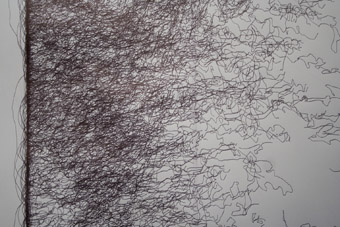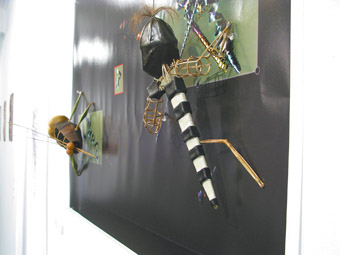creative electronic community
alistair riddell: dorkbot exhibits in canberra

Benjamin Forster, PROCESS=ARTWORK
photo Alexandra Gillespie
Benjamin Forster, PROCESS=ARTWORK
FOR THOSE UNFAMILIAR WITH THE DORKBOT CONCEPT, IT CAN BE THOUGHT OF AS A COLLECTION OF COMMUNITIES AROUND THE WORLD WITH A COMMON INTEREST EXPRESSED THROUGH THE MOTTO “PEOPLE DOING STRANGE THINGS WITH ELECTRICITY.” ESSENTIALLY DORKBOT PROVIDES A LOOSE NETWORK AND STRUCTURE TO FACILITATE ACTIVITIES OF THOSE INTERESTED IN THE FUTURE OF ELECTRONIC ARTS. STARTED IN NEW YORK BY DOUGLAS REPETTO, THE DORKBOT IDEA HAS SPREAD AROUND THE GLOBE. THERE ARE NOW DORKBOT CHAPTERS IN ALMOST ALL AUSTRALIAN CITIES.THE CANBERRA DORKBOT, ESTABLISHED IN EARLY 2008, FINISHED THE YEAR WITH AN EXHIBITION OF WORKS PRESENTED AT THE CANBERRA CONTEMPORARY ART SPACE IN MANUKA IN NOVEMBER.
The immediate impression on entering the exhibition space was of a generous collection of creative practices reaching out into the physical world. The locus of this initial impression was Alexandra Gillespie and Somaya Langley’s collaboration, Collars, with electronics and programming by Ben Lippmeier. This minimal installation, comprising shirt collars on stands with electroluminescent strips of text showing through the material, symbolically questioned power, control and social status. The sound component, based on collected stories from those associated with the shirts, added a further tangible dimension to this installation.
The two other works that functioned in time were by Josh Wodak and Michael Honey. Wodak’s new wave cinema work, Powers That Be, brought together a collage of four voices and associated images into what Wodak described as a “synaesthaic audiovisual relation.” In this instance, one sensory mode triggers or illuminates the other. This synaesthetic experience was interactive in the sense that it is activated by the position of the viewer in the gallery. Honey’s interactive work, Eigenstate, inverted the idea of interaction by generating algorithmic visualisations when the presence of a viewer was not detected by the system. This was a work with explicit reference to scientific concepts, yet the evolution of the imagery had a singularly poetic quality.
In Estuarine Flows, Tracey Meziane Benson presented a series of solar-powered backlit transparencies. These digitally manipulated map images of the boundaries between land and sea reflected the beauty in the structural intricacies of vast environments. The presentation format also seemed calculated to inspire intimacy or personal reflection on the images.
Nathan McGinness’ Leaves was generated through the Processing programming environment. The outcome was visually intriguing and on reflection seemed to question the nature and implications of process in art. It was interesting to consider that although an almost infinite number of outcomes are possible through such a process, the final selection for public presentation is an aesthetic decision made by the artist.
Mitchell Whitelaw’s Limits to Growth reflected a much longer association with generative systems. The elegant prints (about 15) of growth in a model world have a convergent organic and visual information quality. Like the early 1920s works of Mondrian, this collection has the viewer drawn to certain structures without quite knowing why. It would be interesting to correlate a viewer’s focus with the constraints under which the engaging prints were generated. Whitelaw’s second work Watching the Street, was another time-based outcome through the use of slitscan, a time stretching technique using a long series of time-lapse images where narrow slices of each image are extracted and recompiled. The outcome was a visualisation of a scene with curious patterns and an objectivity that we would not appreciate as direct witnesses.

Miles Thorogood, The Developers
photo Mitchell Whitelaw
Miles Thorogood, The Developers
Using recycled materials Miles Thorogood also explored the idea of growth. In The Developers, a three-dimensional construction made from various materials could be seen as an instance from an Artificial Life simulation. Attached to a vertically mounted image were insect-like objects, which seemed to have emerged from a two-dimensional space. One reading of the work is suggestive of our unrelenting expansion and exploitation of the natural environment.
In PROCESS = ARTWORK, Benjamin Forster presented productions from his “drawing machine.” As a triptych of three long “prints”, these reflected an intriguing mechanical insight into interpretation. The work drew on text from Walter Benjamin’s The Work of Art in the Age of Mechanical Reproduction, writings of the Marquis de Sade and images of the grass in Forster’s backyard from the machine itself. The works had a more immediate sense of process when suggesting action and the characteristically nervous scrawl a compelling naiveté. It would have been interesting to see the work generated in real time along with some completed outcomes.
Clem Baker-Finch took a quite different approach in Congregation of the Index with three print works based on the New Testament. Three square prints represented three concentrations of word order: alphabetical, frequency and occurrence were generated. The compelling effect of these lexicons on the viewer was to induce a desire to scan for words and ponder their use and association. This very act prompted curious and often humorous remarks from viewers.
On reflection, the Dorkbot cbr exhibition exemplified the diversity of creativity in electronic arts that is an inherent, long standing and clearly continuing part of the Canberra contemporary art community. To this end, support for the exhibition by David Broker, the director of the Canberra Contemporary Art Space, is to be commended. As with such exhibitions of hybrid practices, diverse formats and sound, the challenge continues for effective presentation with limited time and resources. The complexity and subtlety of each work demanded attention, analysis and reflection and while this could be a challenge for any viewer on a single visit, the overall impression was inspirational.
Dorkbot cbr: Exhibition, People doing strange things with electricity, artists Clem Baker-Finch, Benjamin Forster, Alexandra Gillespie, Michael Honey, Tracey Meziane Benson, Nathan McGinness, Miles Thorogood, Mitchell Whitelaw, Josh Wodak; CCAS (Canberra Contemporary Art Space) Manuka, Nov 7-15, 2008; http://dorkbot.org/dorkbotcbr; International Dorkbot group, http://dorkbot.org
RealTime issue #89 Feb-March 2009 pg. 31






